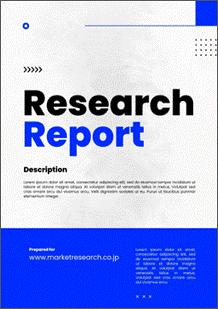 | • レポートコード:MRC2203A774 • 出版社/出版日:Mordor Intelligence / 2022年3月17日 • レポート形態:英文、PDF、114ページ • 納品方法:Eメール(受注後2-3営業日) • 産業分類:医薬品 |
| Single User | ¥703,000 (USD4,750) | ▷ お問い合わせ |
| Site Licence | ¥962,000 (USD6,500) | ▷ お問い合わせ |
| Corporate License | ¥1,295,000 (USD8,750) | ▷ お問い合わせ |
• お支払方法:銀行振込(納品後、ご請求書送付)
レポート概要
| Mordor Intelligence社の本調査資料では、世界の抗体産生市場について調査・分析し、イントロダクション、調査手法、エグゼクティブサマリー、市場動向、抗体種類別(モノクローナル抗体、ポリクローナル抗体、その他)分析、プロセス別(アップストリームプロセス、ダウンストリームプロセス、濾過)分析、エンドユーザー別(製薬・バイオテクノロジー企業、研究所、その他)分析、地域別(北米、ヨーロッパ、アジア太平洋、中東・アフリカ、南米)分析、競争状況、市場機会・将来の傾向などの項目を掲載しています。 ・イントロダクション ・調査手法 ・エグゼクティブサマリー ・市場動向 ・世界の抗体産生市場規模:抗体種類別(モノクローナル抗体、ポリクローナル抗体、その他) ・世界の抗体産生市場規模:プロセス別(アップストリームプロセス、ダウンストリームプロセス、濾過) ・世界の抗体産生市場規模:エンドユーザー別(製薬・バイオテクノロジー企業、研究所、その他) ・世界の抗体産生市場規模:地域別(北米、ヨーロッパ、アジア太平洋、中東・アフリカ、南米) ・競争状況(Applikon Biotechnology Inc.、Cellab GmbH、Danaher Corporation、...) ・市場機会・将来の傾向 |
The major factors for the growth of the antibody production market include the rising adoption of targeted immunotherapy, the increase in the R&D expenditure of pharmaceutical and biotechnology companies, and the rising demand for therapeutic antibodies.
Antibodies are used in the treatment of various diseases, such as cancer, rheunmatoid arthritis, and other chronic diseases. The targeted therapy is attaining importance due to its specificity toward cancer cells, while sparing the toxicity to off-target cells. As there is a rising prevalence of cancer, targeted therapies are getting more attention. For instance, according to the estimates of the American Cancer Society, in 2018, there were 1,735,350 new cancer cases diagnosed and 609,640 deaths, due to cancer, in the United States. Some of the examples of monoclonal antibodies used in targeted therapies are bevacizumab, cetuximab, and ipilimumab.
The rising adoption of targeted therapies are expected to propel the overall growth of the antibody production market over the forecast period. Furthermore, there is an increase in R&D activities by most of the pharmaceutical and biotechnology companies, in order to develop advanced biologics. The success rates and blockbuster sales of biologics have also made large pharmaceutical companies shift their presence to biopharma. Over the past two decades, the chimerization and humanization of mAbs (monoclonal antibodies) have led to the approval of several drugs & therapies for the treatment of autoimmune diseases, cancer, and transplant rejection.
However, the costs of anitbody production and stringent government regulations are expected to impede the growth of the market.
Key Market Trends
THe Monoclonal Antibodies Segment under the Antibody Type Accounted for the Largest Share in the Global Market
Monoclonal antibodies have large applications in the field of diagnostics, therapeutics, and targeted drug delivery systems, not only for infectious diseases caused by bacteria, viruses, and protozoa, but also for cancer, metabolic, and hormonal disorders. This segment is expected to account for the largest market share during the forecast period, owing to the rising investment in monoclonal antibody research and an increase in antibody-based product launches. Furthermore, there is a growing collaboration between pharma companies to develop advanced monoclonal antibodies. For instance, recently, in September 2018, Integral Molecular and Merus NV announced that they have entered into a collaboration on multiple undisclosed targets, as Integral Molecular is one of the leaders in membrane protein antibody discovery. The partnership is expected to increase the R&D capabilities of Merus NV.
The polyclonal antibody segment is expected to be the fastest-growing market, owing to benefits, such as ease of production, low price, and diagnosis of diseases with high proficiency.
North America Accounted for the Largest Share in the Global Market
North America is found to hold a significant share in the antibody production market and is expected to show a similar trend over the forecast period, without substantial fluctuations. The presence of favorable healthcare infrastructure and the rising prevalence of various chronic diseases are the major factors driving the growth of the market. Furthermore, there is a rise in the approval of monoclonal antibodies for the treatment of cancer and various types of diseases, which is one of the major factors contributing to the high growth of the market in North America. For instance, in May 2018, Novartis announced that the US FDA approved Kymriah (tisagenlecleucel) suspension for the treatment of adult patients with relapsed or refractory large B-cell lymphoma.
Competitive Landscape
The market studied is dominated by a few major players, and is expected to grow, owing to the rising collaboration and partnerships between pharmaceutical and biotechnology companies, in order to develop advanced monoclonal antibodies.
Additional Benefits:
- The market estimate (ME) sheet in Excel format
- 3 months of analyst support
1 INTRODUCTION
1.1 Study Deliverables
1.2 Study Assumptions
1.3 Scope of the Study
2 RESEARCH METHODOLOGY
3 EXECUTIVE SUMMARY
4 MARKET DYNAMICS
4.1 Market Overview
4.2 Market Drivers
4.2.1 Rising Adoption of Targeted Immunotherapy
4.2.2 Increase in the R&D Expenditure of Pharmaceutical and Biotechnology Companies
4.2.3 Rising Demand for Therapeutic Antibodies
4.3 Market Restraints
4.3.1 High Costs Involved in the Antibody Production
4.3.2 Stringent Government Regulations
4.4 Porter’s Five Forces Analysis
4.4.1 Threat of New Entrants
4.4.2 Bargaining Power of Buyers/Consumers
4.4.3 Bargaining Power of Suppliers
4.4.4 Threat of Substitute Products
4.4.5 Intensity of Competitive Rivalry
5 MARKET SEGMENTATION
5.1 Antibody Type
5.1.1 Monoclonal Antibodies
5.1.2 Polyclonal Antibodies
5.1.3 Other Antibody Types
5.2 Process
5.2.1 Upstream Processing
5.2.1.1 Bioreactors
5.2.1.2 Consumables
5.2.2 Downstream Processing
5.2.2.1 Chromatography Systems
5.2.2.2 Chromatography Resins
5.2.3 Filtration
5.3 End User
5.3.1 Pharmaceutical and Biotechnology Companies
5.3.2 Research Laboratories
5.3.3 Other End Users
5.4 Geography
5.4.1 North America
5.4.1.1 United States
5.4.1.2 Canada
5.4.1.3 Mexico
5.4.2 Europe
5.4.2.1 Germany
5.4.2.2 United Kingdom
5.4.2.3 France
5.4.2.4 Italy
5.4.2.5 Spain
5.4.2.6 Rest of Europe
5.4.3 Asia-Pacific
5.4.3.1 China
5.4.3.2 Japan
5.4.3.3 India
5.4.3.4 Australia
5.4.3.5 South Korea
5.4.3.6 Rest of Asia-Pacific
5.4.4 Middle East & Africa
5.4.4.1 GCC
5.4.4.2 South Africa
5.4.4.3 Rest of Middle East & Africa
5.4.5 South America
5.4.5.1 Brazil
5.4.5.2 Argentina
5.4.5.3 Rest of South America
6 COMPETITIVE LANDSCAPE
6.1 Company Profiles
6.1.1 Applikon Biotechnology Inc.
6.1.2 Cellab GmbH
6.1.3 Danaher Corporation
6.1.4 Eppendorf AG
6.1.5 GE Healthcare
6.1.6 Genetix Biotech Asia Pvt Ltd
6.1.7 Merck KGaA
6.1.8 Sartorius AG
6.1.9 Solaris Biotech
6.1.10 Thermo Fisher Scientific Inc.
7 MARKET OPPORTUNITIES AND FUTURE TRENDS